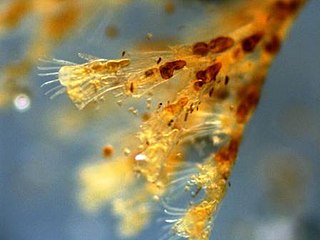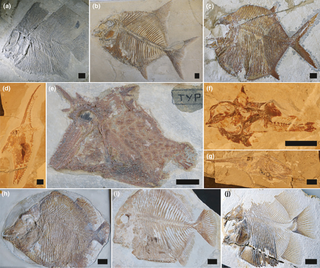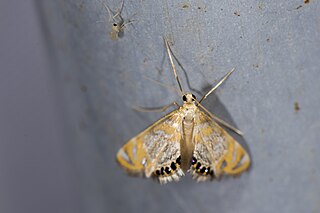
Semionotiformes is an order of ray-finned fish known from the Middle Triassic (Anisian) to the Late Cretaceous (Maastrichtian). Their closest living relatives are gars (Lepisosteidae), with both groups belonging to the clade Ginglymodi within the Holostei. The group includes both freshwater (Semionotidae) and marine adapted forms. Many members of the family Macrosemiidae, had elongated dorsal fins, often associated with an adjacent area of skin which was free of scales. These fins were likely undulated for use in precision swimming. The body morphology of macrosemiids suggests that they were slow swimmers who were capable of maneuvering around complex topography, such as reef environments.

The Lamniformes are an order of sharks commonly known as mackerel sharks. It includes some of the most familiar species of sharks, such as the great white, as well as more unusual representatives, such as the goblin shark and megamouth shark.

Carcharodon is a genus of sharks within the family Lamnidae, colloquially called the "white sharks." The only extant member is the great white shark. The extant species was preceded by a number of fossil (extinct) species including C. hubbelli and C. hastalis. The first appearance of the genus may have been as early as the Early Miocene or Late Oligocene. Carcharocles megalodon is still argued by some paleontologists to be a close relative of Carcharodon carcharias - as well as being in the same genus. The megalodon's scientific name was originally "Carcharodon" megalodon, but more recently, the giant shark has been assigned by most scientists to either the genus Carcharocles or Otodus.

The Lamnidae are the family of mackerel sharks known as white sharks. They are large, fast-swimming predatory fish found in oceans worldwide, though they prefer environments with colder water. The name of the family is formed from the Greek word lamna, which means "fish of prey", and was derived from the Greek legendary creature, the Lamia.

Caturus is an extinct genus of predatory marine fishes in the family Caturidae in the order Amiiformes, related to modern bowfin. It has been suggested that the genus is non-monophyletic with respect to other caturid genera.

Papilio clytia, the common mime, is a swallowtail butterfly found in south and southeast Asia. The butterfly belongs to the subgenus Chilasa, the black-bodied swallowtails. It serves as an excellent example of a Batesian mimic among the Indian butterflies.

Palaeoniscum is an extinct genus of ray-finned fish from the Permian period (Guadalupian-Lopingian) of England, Germany, Turkey, North America and Greenland, and possibly other regions. The genus was named Palaeoniscum in 1818 by Henri Marie Ducrotay de Blainville, but was later misspelled as Palaeoniscus by Blainville and other authors. Palaeoniscum belongs to the family Palaeoniscidae.

Cidaris is a genus of pencil sea urchins.

Myliobatis is a genus of eagle rays in the family Myliobatidae.

Campanulariidae is a family of animals in the phylum Cnidaria, or stinging-celled animals. Campanulariidae is composed entirely of hydroids, a Greek term meaning "water animals" applied to the plant-like polyp colonies of the class Hydrozoa. All species of the Campanulariidae are aquatic in habitat, primarily inhabiting coastal regions and tidal pools.

Albulidae is a family of fish, commonly known as the bonefishes, that are popular as game fish in Florida, select locations in the South Pacific and the Bahamas and elsewhere. The family is small, with 11 species in 3 genera. Presently, the bonefishes are in their own order: Albuliformes. The families Halosauridae and Notacanthidae were previously classified in this order, but are now, according to FishBase, given their own order Notacanthiformes. The largest bonefish caught in the Western Hemisphere is a 16-pound, 3 ounce example caught off Islamorada, Florida, on March 19, 2007.

The Palaeonisciformes, commonly known as "palaeoniscoids" are an extinct grouping of primitive ray-finned fish (Actinopterygii), spanning from the Silurian/Devonian to the Cretaceous. They are generally considered paraphyletic, but their exact relationships to living ray-finned fish are uncertain. While some and perhaps most palaeoniscoids likely belong to the stem-group of Actinopteryii, it has been suggested that some may belong to the crown group, with some of these possibly related to Cladistia and/or Chondrostei. Many palaeoniscoids share a conservative body shape and a similar arrangement of skull bones.

Carcharias is a genus of mackerel sharks belonging to the family Odontaspididae. Once bearing many prehistoric species, all have gone extinct with the exception of the critically endangered sand tiger shark.

Clytia gregaria, sometimes referred to as the gregarious jellyfish, is a small species of hydrozoan in the family Campanulariidae. It is one of the most abundant hydrozoans of the Pacific Northwest, particularly during late spring and summer.

Amblypterus is an extinct genus of freshwater ray-finned fish that lived during the Gzhelian and Cisuralian epoch in what is now Europe and possibly India and Argentina. Potential indeterminate records stretch as far back as the early Carboniferous.

Pycnodontiformes is an extinct order of primarily marine bony fish. The group first appeared during the Late Triassic and disappeared during the Eocene. The group has been found in rock formations in Africa, Asia, Europe, North and South America.

Nymphicula is a genus of moths of the family Crambidae.

Palaeoniscidae is an extinct family of "palaeoniscoid" ray-finned fishes (Actinopterygii). The family includes the genus Palaeoniscum and potentially other Palaeozoic and Mesozoic early actinopterygian genera. The name is derived from the Ancient Greek words παλαιός and ὀνίσκος.
Clytia is a variant of Clytie, the name of several figures in Greek mythology.

















